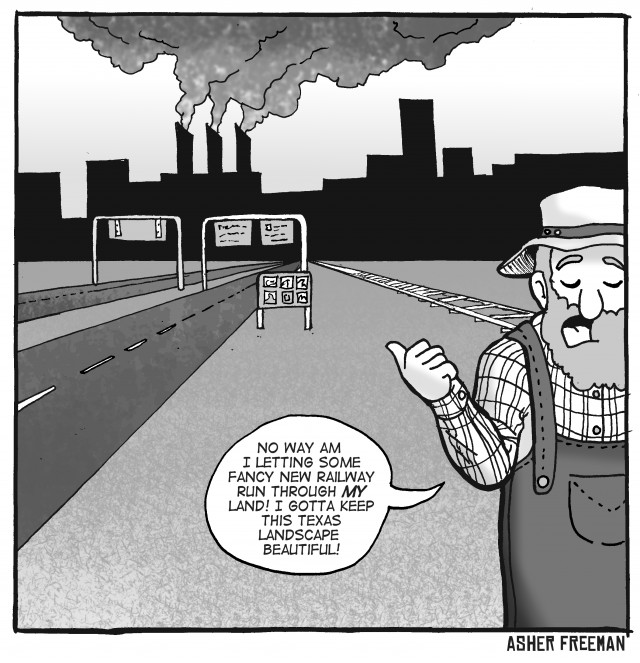The Texas Department of Transportation is conducting a study on the benefits of building a high-speed rail connecting Dallas, Waco, Austin and San Antonio. The plans for the rail include 16 trains a day that would run along a dedicated 100-foot right of way.
While Texas DOT officials have said the costs of the rail are undetermined, they estimate that it would cost around $10.5 billion.
The trains would average 100 to 140 mph and have peak speeds of 220 mph. In addition, officials estimate tickets would be about 80 percent the cost of flying.
A rail system that would connect the four cities along a 300-mile stretch of land is a great idea, especially because it would run through Waco. The study is ongoing and will be completed by the end of the year.
High-speed rails are a sign of progress. The technology is expanding as more countries around the world build these trains. They zoom between cities in countries such as Japan, Italy, Turkey, the United Kingdom, China and Morocco. The United States has one too that runs between Washington D.C. and Boston, with stops in New York, Philadelphia, Baltimore and New Haven.
Those opposed to the trains, especially some people in Texas, have expressed concern that a train would fragment land and properties. This was a concern of the main opposition a decade ago with the Trans-Texas Corridor that would have spanned nearly 4,000 miles and included high-speed rails, commuter trains and freight trains. However, this particular project could be considered too ambitious, because it would have also built tollways and infrastructure for utilities across the state instead of just building a rail. Eventually the project was canceled in 2011 after the Texas public spoke out about the actual cost of building such a massive system.
The current project is not nearly as big and not nearly as intrusive to Texas land.
As reported by the Waco Tribune Herald, Texas DOT spokesman Mark Werner said the study is making it a priority to avoid fragmenting land and instead use land that is already adjacent to railroads and highways.
The urban development director for the Greater Waco Chamber of Commerce, Chris McGowan, said the rail has the potential to increase connectivity between Waco and other cities.
This means that people would have an easier time of commuting between cities along the rail. For Baylor students, this means a faster way to make it to the Dallas-Fort Worth airport or make it home for breaks. For students without cars, the rail would make traveling out of town more convenient. The rail would also help students who want to take advantage of a program at a particular college, such as Baylor, but who originally did not have the time.
Some people may think the time saved during travel is not worth the money spent to build the rail. The study is ongoing, so the statistics on how much time will actually be saved is yet unknown. Interstate 35 does offer a connection between the cities the rail would connect, but oftentimes travel is slow due to construction, accidents or weather. These things would not affect the rail. In fact, a rail could potentially decrease congestion on the interstates.
The other benefits of the rail make it worth the cost. Gas is expensive and traveling by rail cuts oil consumption costs. In a world that has an ever increasing call for “green” products, the rail would run on electricity. According to the US High Speed Rail Association, the rail pays for itself as it reduces the United State’s need to purchase oil. High-speed rails are green, fast and convenient, as well as profitable with potential 14 percent revenue over maintenance costs.
As the study continues, people should be open to the possibilities the rail would bring to Waco and surrounding cities. They’ll most likely find that the benefits outweigh the costs.






